We drive south on Louisiana Highway 55 towards Pointe-au-Chien. The two-lane road hugs a bayou, like most of the roads leading south into the marsh areas. Incredibly green, lush forest gives way to increasing areas of water the further south we venture, until the very road feels as though it is floating.
We cross over a small concrete bridge over another bayou and find ourselves square in front of the Pointe-au-Chien sign informing us this is their tribal area. We’ve come to meet Theresa Dardar, in order to learn more about how the BP oil disaster is decimating the indigenous populations of Southern Louisiana.
Theresa is a member of the Pointe-au-Chien Indian Tribe. They are a small community of self-described Indians that live in southern Louisiana along a small stretch of the Bayou Pointe-au-Chien. Now, oil from the BP disaster threatens their very existence.
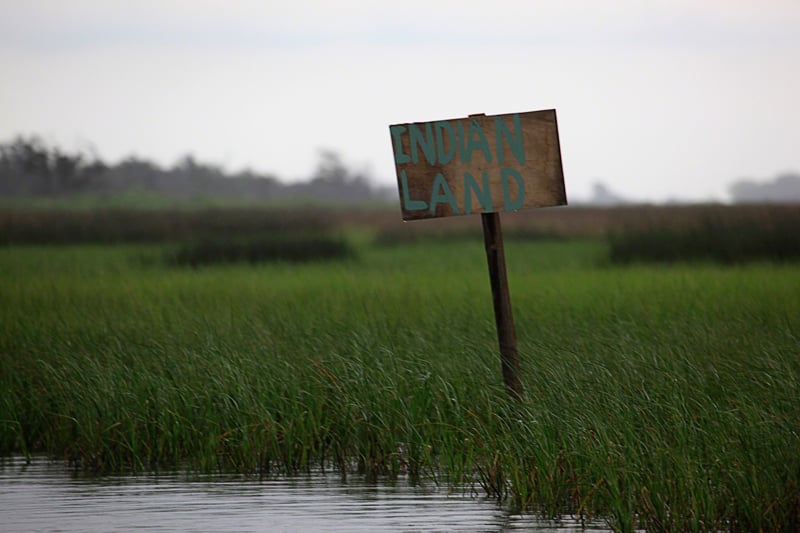
Photo by Erika Blumenfeld © 2010
Historically, they have been a community reliant upon hunting, fishing, agriculture, and cattle. But due to, as Theresa puts it, “devastation of our land by the oil companies,” the lack of protection of the barrier islands and lack of fresh water replenishment and saltwater intrusion, the Tribe has had to rely primarily on fishing to sustain itself.
On May 29, the shrimping season was closed in their area, putting most of the tribe out of work. On June 19, shrimping season reopened when oil in nearby bays abated somewhat, but shrimping was and still is only allowed in the Cut-Off Canal-a tiny area compared to what they are usually allowed access to.
This is what Theresa is most concerned about-behind of course, their land vanishing beneath their feet as it is, like much of the rest of southern Louisiana, swallowed up by the Gulf of Mexico.
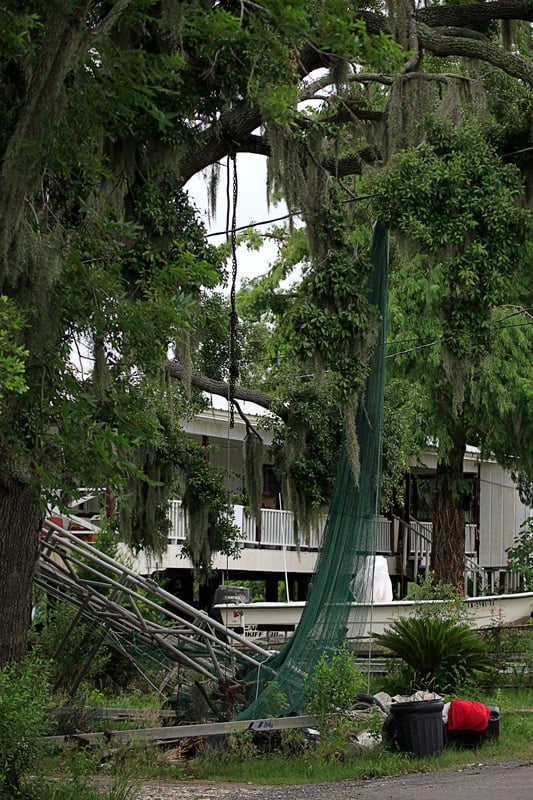
Photo by Erika Blumenfeld © 2010
Today, members of her tribe, including her husband, spend their days contracting their shrimp boats to BP in order to lay out boom, instead of being in the midst of a busy and fruitful shrimping season.
Outside her home, like that of her neighbors, huge green nets hang from trees. Other fishing gear sits idly in yards, indicative of a way of life being placed on indefinite hold.
Theresa invites us inside her home, located among several other elevated houses that perch on the bank of the bayou. It is an area surrounded by marsh-much more water than land. It’s an amazing experience to be in Louisiana’s marsh-whether driving on the roads, or walking to someone’s home, the water is so near, and the land barely above it, one often feels as though the water is actually higher than the land. The feeling of it possibly spilling onto the land is ever present.
“We are praying we don’t have a hurricane, because if we do it’ll blow the oil up here, they’ll condemn this place and not let us back in until we clean it up,” she explains. I later learn that this is a fear shared by basically everyone in the area.
Given the encroachment of what’s left of their land by the Gulf, Theresa and the rest of her tribe intend to hold onto what they have. This is among their priorities listed on the Tribes’ website, that includes the following goals:
-Protect Village, Sacred Sites, Fishing Grounds, and Cultural Sites.
-Plan needed for evacuation and relocation to keep tribal members together in the event of flooding–even with a tropical depression–for an unknown period of time.
-Workforce training and development in the event the oil spill contaminates fisheries for an extended period of time.
-Build tribal center to be used for relief and recovery efforts.
-Health issues associated with change in diet and stress from oil spill.
-Houses that haven’t been elevated are at risk for condemnation if oil enters the community.
They are a people used to looking after themselves. “We fend for ourselves,” Theresa continues, as we sit in her living room talking, “We can’t wait for the Parish, or the State, to help us. The only time we see a politician is during election time, or when they come after we have a disaster and we’ve pretty much cleaned everything up ourselves.”
Theresa says they want to put a sign up near the bridge one must cross to enter their area, one that reads, “No politicians allowed.”
The area is also home to Indians that align themselves with the United Houma Nation and the Biloxi-Chitimacha Confederation of Muskogees. The land here is considered precious by the tribal community, and it includes at least seven cemeteries that contain the remains of their ancestors.
The livelihood of generations of these people is now threatened on multiple fronts-but for now, the most imminent threat seems to be oil lurking off-shore. According to Theresa, her tribe is now down to only 680 people, and the majority of them live in Pointe-au-Chien.
Like indigenous people around the world, place is paramount. Theresa speaks of their tie to the area in reverential tone. To be removed from this place is to disintegrate, figuratively and literally, her tribe.
“If we have to leave, we’ll be spread out and no longer be a community,” she explains, “We don’t know where we’d go. BP should try to keep this community together because it’s their oil that’ll cause us to separate. Our attachment to our land is everything to us. We live off the land, so when you take us away, it won’t be the same. It’s like taking a fish out of water and seeing how long it will live.”
She stops talking, and simply says that she doesn’t know how to describe this.
Her 54-year-old husband has been a fisherman since he was 16. Now he’s laying out boom for BP-a job that is temporary. Theresa tells me her husband is angry at BP for having put him out of his fishing job, but he needed the money so took the job laying boom for the company that destroyed his livelihood. It’s a job that won’t likely end soon, but when it does, he won’t likely have his old job to return to.
She walks us outside, because her brother-in-law, Russell Dardar, is sitting out near the bayou after having just returned from crabbing. He shows us one of his boxes of crabs. One of the blue crabs reaches into the air, pincher open. “He’s giving you the peace sign,” Russell says with a half-smile.
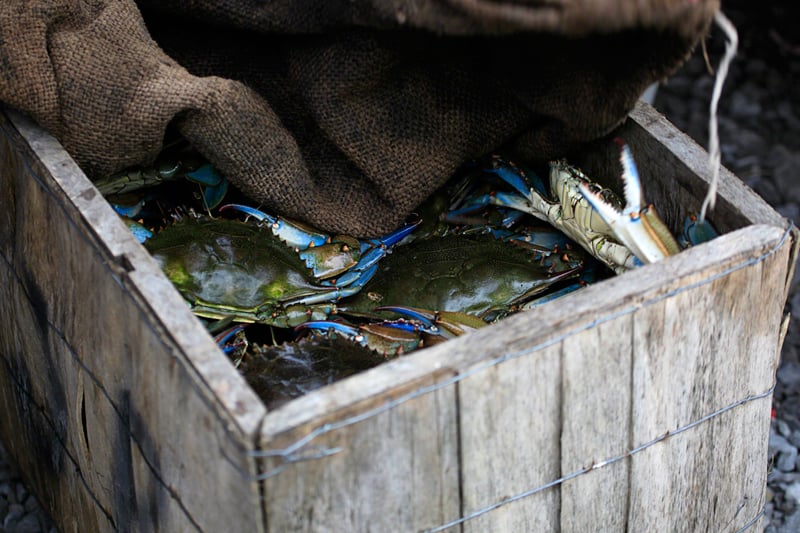
Photo by Erika Blumenfeld © 2010
Russell, wearing cut-off jeans and a t-shirt, is shoeless and completely in his element. He’s going to take us out on his boat to show us where he’s seen oil soiling the marshes in the area where he usually crabs. He’s free to do so since he won’t work for BP.
After looking at his photos of oil-affected marsh, we climb into his boat and start idling down the bayou. It’s a tight waterway, lined with shrimp boats that would, in a time without an oil disaster, be out harvesting.
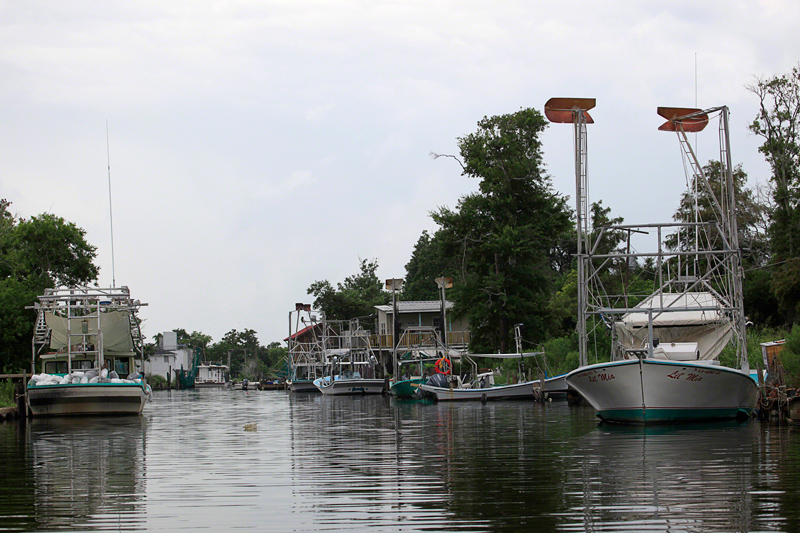
Photo by Erika Blumenfeld © 2010
Russell doesn’t talk much, but when he does, it is impactful. He tells me he used to work on a tugboat, work that is common with many of the people in this area of southern Louisiana, until a back injury led him back to crabbing and shrimping.
I ask him how many of the folks in his community are working for BP laying boom. “Maybe there are four or five of us left crabbing,” he replies while looking straight ahead as we pass empty boats. I eye stacks of empty crab traps sitting on vacant piers.
It is gray, and dark rain clouds loom out in the marsh where we are headed. The rain begins slowly as we motor down the tight canal-green marsh on either side as we voyage down towards the head of the bay. The rain increases into a full shower, lightening flashes in the distance. We’re all soaked within minutes. Erika sits in the front of the boat taking photos, her camera wrapped in its storm jacket. I’m in front of Russell, sitting in a white plastic patio chair while he pilots us along. I look up at him amidst the warm downpour and he smiles, which is a rarity, as he is usually completely focused on whatever it is he is doing.
He pulls us up amongst white booms bobbing in the small waves. They are held in place by flimsy white PVC pipes stuck in the mud-bamboo poles hold them in other areas.
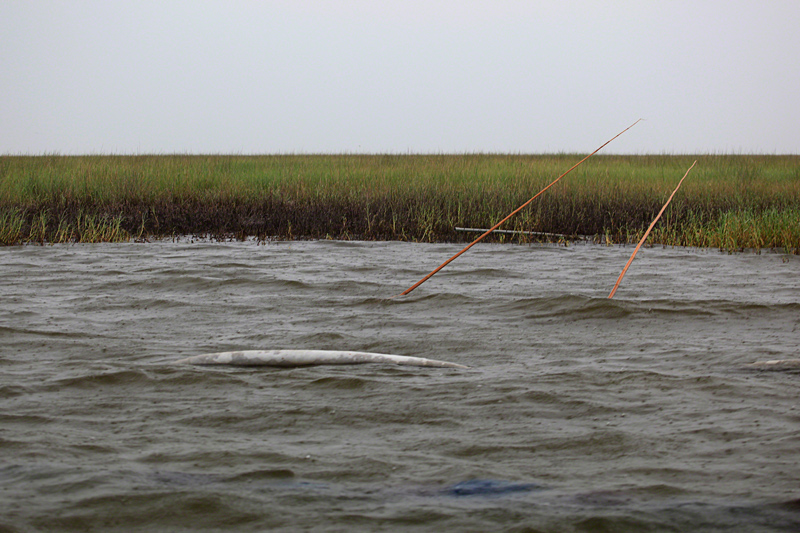
Photo by Erika Blumenfeld © 2010
We are struck by how useless they are. Several oil-scarred areas of marsh lie behind booms that are sometimes unattached to their support poles. Other areas float half a foot below the surface. In many areas, booms are washed ashore and sit amidst oil-soaked marsh.
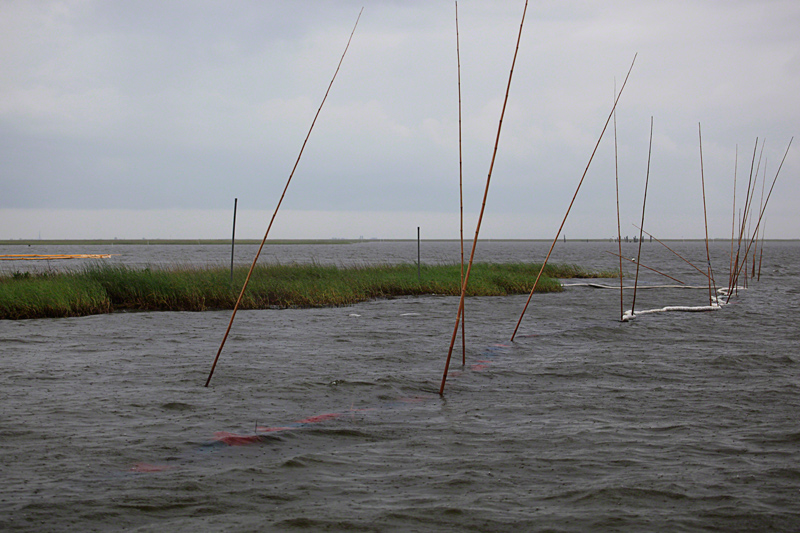
Photo by Erika Blumenfeld © 2010
I look back at Russell to find him looking off into the distance, across the marsh, with a stern face.
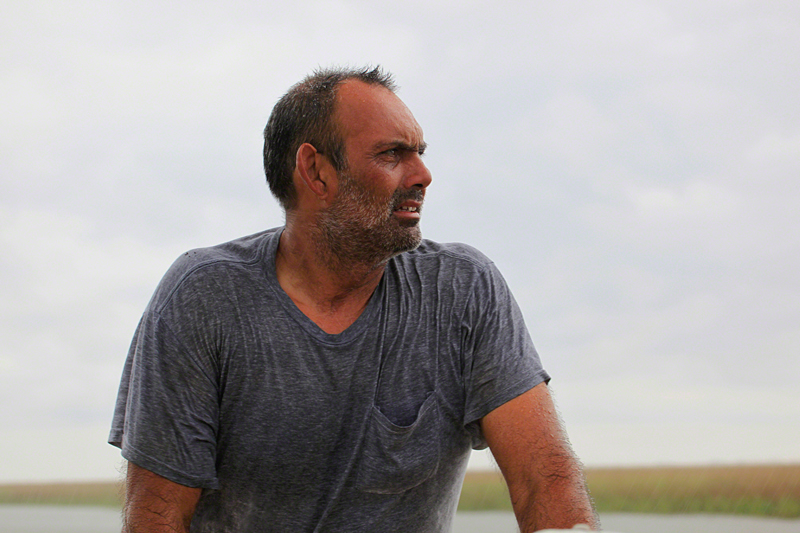
Photo by Erika Blumenfeld © 2010
“These are completely useless,” I say to him. “It’s good for show,” he responds while swinging the boat around in the surf.
He takes us along many areas to show us more of the same-sunken boom, boom washed ashore, oil-scarred soiled areas of marsh that is already dead.
“There was far more oil out here last week,” Russell explains, “But the high tides that reached here from Hurricane Alex pushed all the oil deeper into the marsh.”
The rain slackens as we head back home. Incredible bird life fills the marsh as we motor back…flocks of birds, everywhere.
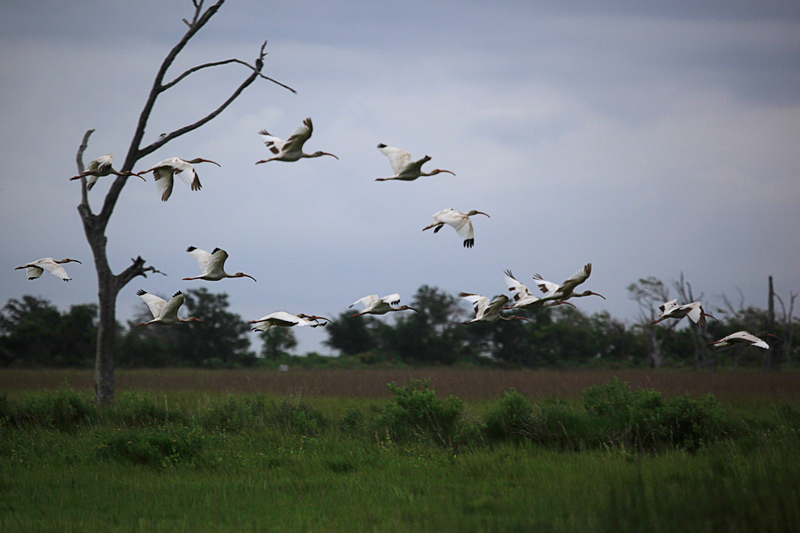
Photo by Erika Blumenfeld © 2010
I wonder how long they’ll last.
As we arrive back at the marina, I see that it has been turned into a staging area by BP. As though to intentionally underscore the futility of the so-called clean up effort, mountains of boom sit in plastic wrap on the shore, waiting to be taken out into the marsh. To the right of the marina building a statue of Jesus stands near a US flag, facing the mounds of boom, his arms outstretched as if he is questioning the futility of it all.
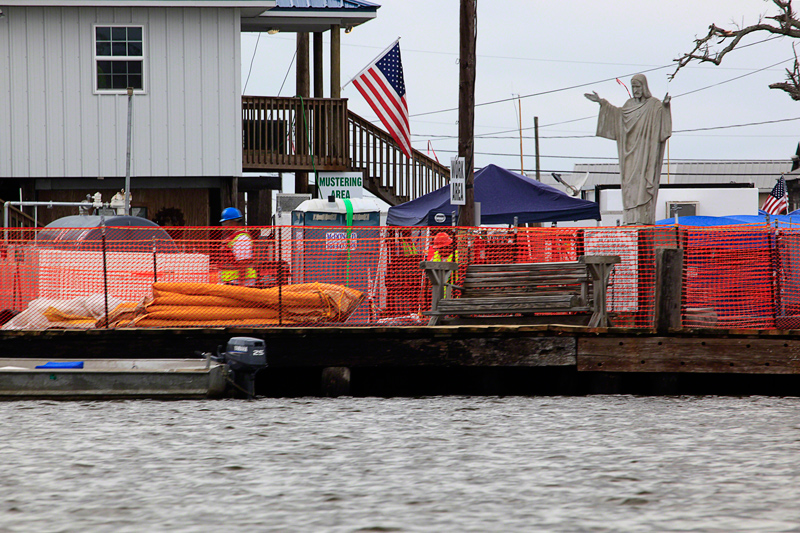
Photo by Erika Blumenfeld © 2010
In the front of the Marina another US flag stands above more piles of boom. Erika later finds, upon closer inspection of the photo, it has an indigenous man atop a horse painted on the flag.
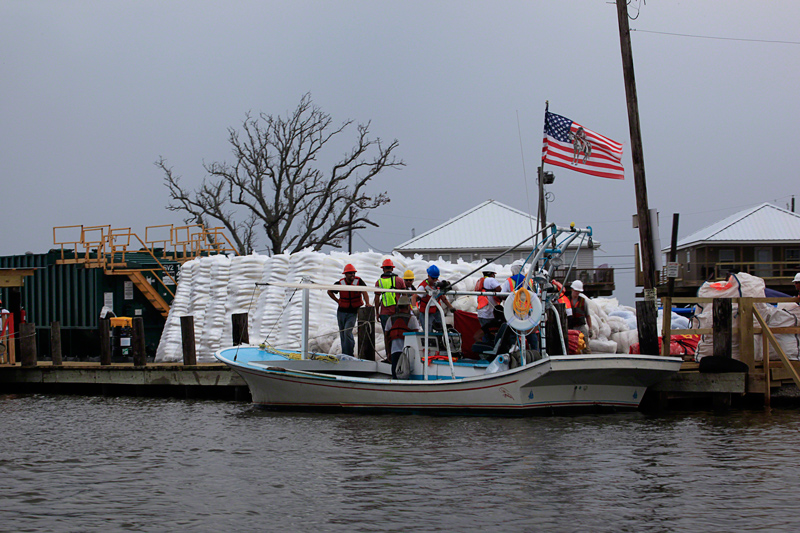
Photo by Erika Blumenfeld © 2010
When she shows this to me, blown up on her computer, we can only shake our heads.
We idle the rest of the way up the bayou to Russell’s dock and park the boat. Back on land he tells me how BP has promised everyone it’s safe to work laying boom. “Somethin’ don’t sound right about that to me,” he adds.
I thank Russell, shaking his hand, telling him I hope to see him again, and we walk over to Theresa’s house to tell her goodbye. She brings us inside, however, and says, “I knew you’d be wet and hungry, so I made you lunch.”
We sit down and feast on the crab casserole and fried shrimp she has made us while she tells us about a recent meeting at their town hall.
“About two weeks ago a BP spokesman held a town hall meeting,” she explains, “He said, it’s not if but when the oil comes here again. There was not one state or parish official at the meeting. BP is running things here now.”
We finish eating and talk a little while longer before we thank Theresa again for her time and hospitality.
“We hope we don’t have to wait as long as the Alaskans did for our marine life to come back,” she says, referencing the Exxon Valdez disaster from 1989, “They had to wait 17 years for their shrimp to return, and they are still waiting on their herring.”
It’s a slim hope, considering the fact that to date 14 percent of the 250,000 barrels spilled in the Valdez disaster have been recovered. Even by the most conservative estimates, the ongoing BP disaster has erupted many times that amount of oil into the Gulf-and kept most of it underwater via dispersant. Higher-end estimates of the amount of oil erupting from the floor of the gulf show an Exxon Valdez worth of oil injected into the Gulf every two and a half days.
“I’m worried about health problems associated with this disaster,” Theresa tells us before we leave, “And we’re hoping we can avoid the divorces, suicides and alcoholism that hit so many communities up in Alaska. I’m telling people to stay busy and not think of the oil. Otherwise, you’ll drown in it.”
Our most important fundraising appeal of the year
December is the most critical time of year for Truthout, because our nonprofit news is funded almost entirely by individual donations from readers like you. So before you navigate away, we ask that you take just a second to support Truthout with a tax-deductible donation.
This year is a little different. We are up against a far-reaching, wide-scale attack on press freedom coming from the Trump administration. 2025 was a year of frightening censorship, news industry corporate consolidation, and worsening financial conditions for progressive nonprofits across the board.
We can only resist Trump’s agenda by cultivating a strong base of support. The right-wing mediasphere is funded comfortably by billionaire owners and venture capitalist philanthropists. At Truthout, we have you.
We’ve set an ambitious target for our year-end campaign — a goal of $250,000 to keep up our fight against authoritarianism in 2026. Please take a meaningful action in this fight: make a one-time or monthly donation to Truthout before December 31. If you have the means, please dig deep.
